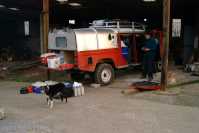
![]()
 |
 |
![]()
|
|
Preparing the vehicle
Acquiring the right vehicle in the first place was the hardest part of all the preparation. Or so we thought! The next problem was what to equip it with. It is very easy to go over-board and carry heaps of gear that will never get used! As far as recovery equipment went, the choice was not too hard. Numerous off-roading trips to Wales and Salisbury Plain as well as our local “come and get you 4*4 as dirty as possible” site – Devil’s Pit in Bedfordshire had taught exactly what does and does not get used. Our biggest expense after the vehicle was the electric winch. All of our previous trips have involved Gus (the only one of our group with an electric winch) hauling the rest of us out of a bottomless hole somewhere! We decided on a Superwinch Husky, partly because we have a good, friendly local supplier (Sling & Tackle, Milton Keynes) but mainly because Gus’ had served him very well for a number of years, and we could pick no faults with it. Along with the winch we bought an assortment of nylon ropes, tree-strops, and D-shackles. Hopefully enough to find and secure a decent anchor point! Hi-lift jacks are an essential, so many uses – lifting, pulling, clamping! We have two 5’ genuine Hi-Lifts. Two because twice in the past I have seen people bend the rack. Agreed, if you are careful this shouldn’t happen, but there is no accounting for the unexpected! We also have a pair of aluminium sand ladders. To date, the only items that we have not had call to use. Still not sure how useful they are - I guess very if you find some soft sand! The first accessory that we bought was a stereo. Not the most essential item you may think. Believe me, after a couple of months of Turkish, Iranian, Pakisani and Indian music – playing your own CD collection is VERY satisfying! We chose one with a separate 10 CD autochanger, not only does this save having to handle the discs all the time, but also it allows the “technical bit” to be hidden away out of the dust and inquisitive eyes. The part on the dashboard doesn’t look like anything special. Next came a good array of spotlights. You can’t have too many! When camping, the ones that point sideways and backwards are invaluable. The four across the front of the roof rack are very good at “replying” to the non-stop “get-out-of-my-way” flashing experienced in Iran & Pakistan!! We also bought a 12v dc to 240v ac power inverter. The main reason was that it worked out cheaper than buying 12v adapters for the numerous rechargeable gadgets we have (electric shaver, camera, phone, computer). It also meant that I could carry some basic power tools in case of emergency repairs! The inverter is a Cherokee “Platinum Series”, capable of suppling a continuous 1000w. Chosen partly on price, but mainly on specification and availability from stock in the UK. The final luxury item was a freezer. Made by Waeco, the “Coolmatic” is fantastic. Outwardly it is no larger than an insulated cool-box. However, squeezed into a small compartment underneath is a conventional compressor refrigeration unit. Capable of maintaining well below freezing everywhere we have used it so far. Setting the thermostat to a degree or two above freezing seems to use very little battery power, but keeps drinks lovely and cold. (and, most importantly, our supply of Mars Bars from melting!) In order to power all these electrical devices it was clear that the standard Landrover system needed upgrading. It was decided that the best way was to power all accessories from a second battery, thus making it near impossible to flatten the starter battery! Numerous options are available for charging two batteries from the existing vehicle alternator, none of which appealed to me very much on the grounds of low power output, poor battery management (reduced life expectancy), and price. A cheaper alternative was simply to install a second alternator on the opposite side of the engine to the original. Very easy since Landrover had conveniently fitted a spare belt pully already (presumably for optional air-con). The 120amp Lucas alternator that we fitted is more than capable of providing enough power for all our accessories! It will even maintain the electric winch (within it’s duty cycle). Other vehicle modifications3. Roof-rack
The first piece of advice every one is keen to give is always “don’t put too much on the roof!” (especially Tim & Gea, our friends in Australia, after their Landcruiser inversion episode on the Birdsville Track!) Agreed, overloading the roof is not a good idea (fuel economy is reduced, as well as balance) however, it does offer an invaluable space for light, bulky items. After a Sunday morning trip to Rogers of Bedford, our local Landrover specialist, we somewhat fell for the all-aluminium Hanibul Roof-racks that they are agents for. Lightweight, very strong and stylish too! After a few minor modification (shortening the mounting brackets designed to fit a 90 to fit a crew-cab roof – carried out at no extra charge) we took delivery the following weekend. A roofrack also makes a very good, allbeit expensive, bracket for mounting cab spotlights! 4. Hard top
The next problem (sorry, challenge) was converting the open pick-up into a covered van. We needed a hard top both for security, and so we could sleep in the back. We settled for an Ifor Williams aluminium hard top, mainly due to cost. It worked out at about a third of the price of a certain well-known GRP brand! Once we had lined the inside with 10mm thick, closed cell foam the condensation problem was cured too! We boarded out the back, level with the existing pick-up body, providing equipment storage underneath, and an accomodation area on top. How much fuel to carry (or be able to carry when necessary) is always a difficult question to answer. We decided that if we had the equivelent of three full standard tanks of diesel, we would be ok for just about any eventuality. The standard landrover tank (80 litres) always gets us 650km – so a tank cabable of holding a further 160 litres should carry us about 2,000 km. We both agreed that we did not want to be any further than 2,000km from the nearest fuel!! A similar problem to fuel. Clearly every litre is another kg in weight, but being able to have a supply of (safe) water anywhere is of paramount importance. We already had a couple of plastic jerry-cans (25 litres each) the question was how much more. In the end we decided on 125 litres, the equivelent of 5 more jerry-cans. This seems a lot when you are in England, but in Australia it is recommended that you have enough water for 10 litres per person per day. At this rate we still have little over 1 week supply. The tanks Where to put the tanks. The whole point for having tanks instead of jerry-cans is being able to keep the weight low down (i.e. NOT on the roof!) and to be space efficient. In the end we came up with a T shaped design that dropped into the pick-up body right at the front and under our boards. Surpisingly 125 litres takes less than 200mm from the fron of the pick-up. This design has two advantages over “belly-tanks”, primarily cost. Elaborate shape tanks designed to fit around the chassis members take a long time make, or cost a lot of money for off-the-shelf models. Also they are in a prime position for being holed on rocks. A friend, Tim Life, came up trumps here. Making both tanks in a couple of weekends. The added advantage being that he has access to a TIG welder, so our water tank is stainless steel! I would like to thank my sister, Alison, for lending us Tim! Both tanks are filled through locking filler-caps, situated in the side of the Ifor Williams hard-top, and are emptied with submersible “Whale” pumps. The water is pushed by a high pressure pump through a 2-stage filtration system. The first stage is a spun-polypropylene cartridge in a standard ISO housing. This removes particles and sediment. Next the water passes through a General Ecology Nature-Pure filter, combining a very fine membrane and active charcoal to remove odours and tastes. Fine enough (so they claim) to remove bacteria and virus. We filter our water in batches – we have a jerry-can with a tap for day-to-day use, and fill it through the filters from the tank as and when necessary. The water in the main tank is treated with chlorine tablets, but the taste is totally removed by the filters. With all these accessories fitted, and both tanks full, the Landrover weighs in at a little over 3,300kg. Still some clear of the maximum of 3,500kg! For 90% of the time there is no need to carry so much extra fuel and water though, so our weight is well within recommended limits. |
![]()
![]()
Website created by Jo
Peters
Page last updated 08 May 2000 by Jo Peters
Disclaimer
Copyright © 1999 Jo Peters. All rights reserved.